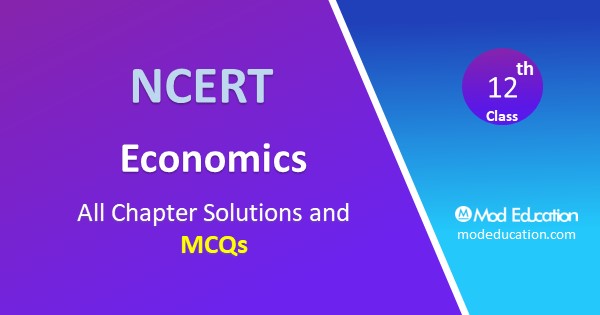MCQ Questions for Class 12 Economics Chapter 9 : Class 12 Chapter 9 “Environment and Sustainable Development” MCQ Questions for Class 12 Economics with Answers PDF Free Download here according to the latest CBSE syllabus and NCERT curriculum.

MCQ Questions for Class 12 Economics Chapter 9 Environment and Sustainable Development with PDF
Here CBSE RBSE and Other State Board NCERT Objective MCQ Questions of Class 12 Economics Chapter 9 “Environment and Sustainable Development” with Answers Pdf will guide students to do a quick revision for all chapter.
Q1. Which of the following is not a biotic element?
(A) Birds
(B) Sunlight
(C) Forests
(D) Animals
(B) Sunlight
Q2. Which of the following is a renewable resource?
(A) Fish
(B) Coal
(C) Petroleum
(D) Iron-ore
(A) Fish
Q3. Which of the following is an impact of global warming?
(A) Deforestation
(B) Rise in sea level
(C) Waste generation
(D) Rapid increase in population
(B) Rise in sea level
Q4. In which of the following layers of the atmosphere is ozone shield found?
(A) Troposphere
(B) Exosphere
(C) Stratosphere
(D) Mesosphere
(C) Stratosphere
Q5. Which of the following is a consequence of ozone layer depletion?
(A) Skin cancer in humans
(B) Lower production of phytoplankton
(C) Hampers growth of terrestrial plants
(D) All of the above
(D) All of the above
Q6. When was the Central Pollution Control Board (CPCB) set up?
(A) 1964
(B) 1974
(C) 1984
(D) 1994
(B) 1974
Q7. How many industrial categories have been identified as significantly polluting by the CPCB?
(A) 17
(B) 25
(C) 27
(D) 31
(A) 17
Q8. Which of the following is the modern concept of development?
(A) Economic development
(B) Economic growth
(C) Sustainable development
(D) Human development
(C) Sustainable development
Q9. Use of which of the following has resulted in a significant reduction in Delhi’s pollution?
(A) LPG at homes
(B) Solar cells for electricity
(C) Thermal power plants
(D) CNG in public transport
(D) CNG in public transport
Q10. Which of the following is a conventional source of energy?
(A) Sun
(B) Wind
(C) Dried dung
(D) Tides
(C) Dried dung
Q11. Sunlight is an example of ______ elements.
abiotic
Q12. ______ resources are those which get exhausted with extraction and use.
Non-renewable
Q13. The absorptive capacity of the environment is the ability to absorb ________
degradation
Q14. Global warming is caused due to increase in greenhouse gases through the burning of fossil fuels and ________
deforestation
Q15. In India, the ________ of the Deccan Plateau is particularly suitable for the cultivation of cotton.
black soil
Q16. The origins of chlorine and bromine compounds in stratosphere are ________
chlorofluorocarbons
Q17. _______ emissions are the major contributors to air pollution in urban areas of India.
Vehicular
Q18. The CPCB has identified _______ categories of industries as significantly polluting.
seventeen
Q19. Thermal power plants emit large quantities of ________ which is a greenhouse gas.
carbon dioxide
Q20. ________ plants use the energy of such streams to move small turbines.
Mini-hydel
Q21. Fossil fuels can be used without the possibility of these becoming depleted or exhausted.
False
More MCQ Questions for Class 12 Economics Chapter 9 Environment and Sustainable Development with Answer
Question 1. World Environment Day is observed on
(i) 5 June
(ii) 15 August
(iii) 1 January
(iv) 5 September
(i) 5 June
Question 2. Which of the following is not a biotic element?
(i) Birds
(ii) Sunlight
(iii) Forests
(iv) Animals
(ii) Sunlight
Question 3. Sustainable development can be achieved by
(i) controlling pollution
(ii) controlling the growth of population
(iii) restricting use of renewable resources
(iv) all of these
(iv) all of these
Question 4. In which of the following layers of the atmosphere is ozone shield found?
(i) Troposphere
(ii) Exosphere
(iii) Stratosphere
(iv) Mesosphere
(iii) Stratosphere
Question 5. In which of the following layers of the atmosphere is ozone shield found?
(i) Troposphere
(ii) Exosphere
(iii) Stratosphere
(iv) Mesosphere
(iii) Stratosphere
Question 6. Which of the following is an impact of global warming?
(i) Deforestation
(ii) Rise in sea level
(iii) Waste generation
(iv) Rapid increase in population
(ii) Rise in sea level
Question 7. When was the Central Pollution Control Board (CPCB) set up?
(i) 1964
(ii) 1974
(iii) 1984
(iv) 1994
(ii) 1974
Question 9. How many industrial categories have been identified as significantly polluting by the CPCB?
(i) 17
(ii) 25
(iii) 27
(iv) 31
(i) 17
Question 10. Which of the following is the modern concept of development?
(i) Economic development
(ii) Economic growth
(iii) Sustainable development
(iv) Human development
(iii) Sustainable development
Question 11. The government set up the Central Pollution Control Board to control _
(i) noise pollution
(ii) air pollution
(iii) deforestation
(iv) land pollution
(ii) air pollution
Question 12. Which of the following is a conventional source of energy?
(i) Sun
(ii) Wind
(iii) Dried dung
(iv) Tides
(iii) Dried dung
